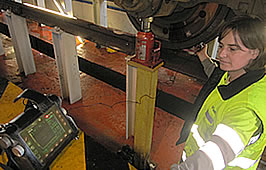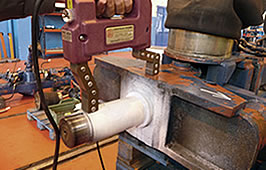One of the most important aspects of rail maintenance is the use of non-destructive tests of metal components to rule out the existence of fissures in wheels, axles and bogies.
Our employees and engineers are certified to conduct these tests.
For example, to detect fissures using ultrasound technology, we use a General Electric USM35 machine on axles and wheels.
Ultrasound inspection is based on measuring the time during which a high frequency sound wave bounces off the surfaces it encounters along the way. Using the speed at which the sound wave is emitted, it is possible to calculate the distance of the surface against which it has rebounded. Consequently, if there is a fissure deep inside the body being tested, an echo will be seen at the depth of the fissure.
Penetrating liquids are used to detect external fissures on larger metal components, such as bogies.
Penetrating liquid technology is based on impregnating the surface of the body under study with a low viscosity and brightly-coloured liquid to detect external fissures. Once the liquid has penetrated the fissure, the surface is cleaned and a revealer is applied to extract the liquid trapped inside the fissure.
A magnetoscope is used to check for fissures on smaller, easily accessible surfaces, such as traction hooks or levers, or to check welding results.
Magnetoscope technology consists of obtaining the image that is created when an external magnetic field is applied to a magnetic metal body. Using the irregularity of the magnetic field that is created by the heterogeneousness of the fissures in the metal body under study, the irregularity becomes visible when a liquid rich in magnetisable particles is applied to a white background. These particles are arranged coherently with the lines of force applied, including the irregularities which the test is trying to detect.





